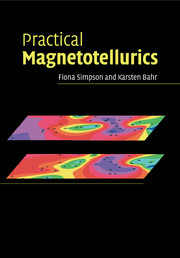Book contents
- Frontmatter
- Contents
- Preface
- Symbols
- 1 Introduction
- 2 Basic theoretical concepts
- 3 Planning a field campaign
- 4 From time series to transfer functions: data processing
- 5 Dimensionality and distortion
- 6 Numerical forward modelling
- 7 Inversion of MT data
- 8 The general link to other geosciences: conduction mechanisms
- 9 The special link to other geosciences
- 10 Other EM induction techniques
- Appendix 1 Theorems from vector calculus
- Appendix 2 The transfer function in the wavenumber-frequency domain and equivalence transfer functions
- Appendix 3 Probability distributions
- Appendix 4 Linear regression
- Appendix 5 Fourier analysis
- Appendix 6 Power and cross spectra
- Glossary
- References
- Index
1 - Introduction
Published online by Cambridge University Press: 03 December 2009
- Frontmatter
- Contents
- Preface
- Symbols
- 1 Introduction
- 2 Basic theoretical concepts
- 3 Planning a field campaign
- 4 From time series to transfer functions: data processing
- 5 Dimensionality and distortion
- 6 Numerical forward modelling
- 7 Inversion of MT data
- 8 The general link to other geosciences: conduction mechanisms
- 9 The special link to other geosciences
- 10 Other EM induction techniques
- Appendix 1 Theorems from vector calculus
- Appendix 2 The transfer function in the wavenumber-frequency domain and equivalence transfer functions
- Appendix 3 Probability distributions
- Appendix 4 Linear regression
- Appendix 5 Fourier analysis
- Appendix 6 Power and cross spectra
- Glossary
- References
- Index
Summary
Magnetotellurics (MT) is a passive exploration technique that utilises a broad spectrum of naturally occurring geomagnetic variations as a power source for electromagnetic induction in the Earth. As such, MT is distinct from active geoelectric techniques, in which a current source is injected into the ground as a power source for conduction. In fact, MT and geoelectrics have little in common other than the physical parameter (electrical conductivity) imaged. MT is more closely related to geomagnetic depth sounding (GDS), which was developed in the late nineteenth century after the existence of magnetovariational fields arising from induction was demonstrated by Schuster (1889) and Lamb (see Schuster, 1889, pp. 513–518). They applied a mathematical technique, invented by Gauss (1839) for separating magnetovariational fields originating internal to the Earth from those of external origin, to geomagnetic observatory data and detected a significant internal component. In the 1950s, Tikhonov (1950, reprinted 1986) and Cagniard (1953) realised that if electric and magnetic field variations are measured simultaneously then complex ratios (impedances) can be derived that describe the penetration of electromagnetic fields into the Earth. The penetration depths of electromagnetic fields within the Earth depend on the electromagnetic sounding period, and on the Earth's conductivity structure. This is the basis of the MT technique.
Magnetotellurics as a passive electromagnetic exploration method and its relation to active electromagnetic and geoelectric methods
The magnetotelluric (MT) technique is a passive electromagnetic (EM) technique that involves measuring fluctuations in the natural electric, E, and magnetic, B, fields in orthogonal directions at the surface of the Earth as a means of determining the conductivity structure of the Earth at depths ranging from a few tens of metres to several hundreds of kilometres.
- Type
- Chapter
- Information
- Practical Magnetotellurics , pp. 1 - 14Publisher: Cambridge University PressPrint publication year: 2005
- 15
- Cited by



